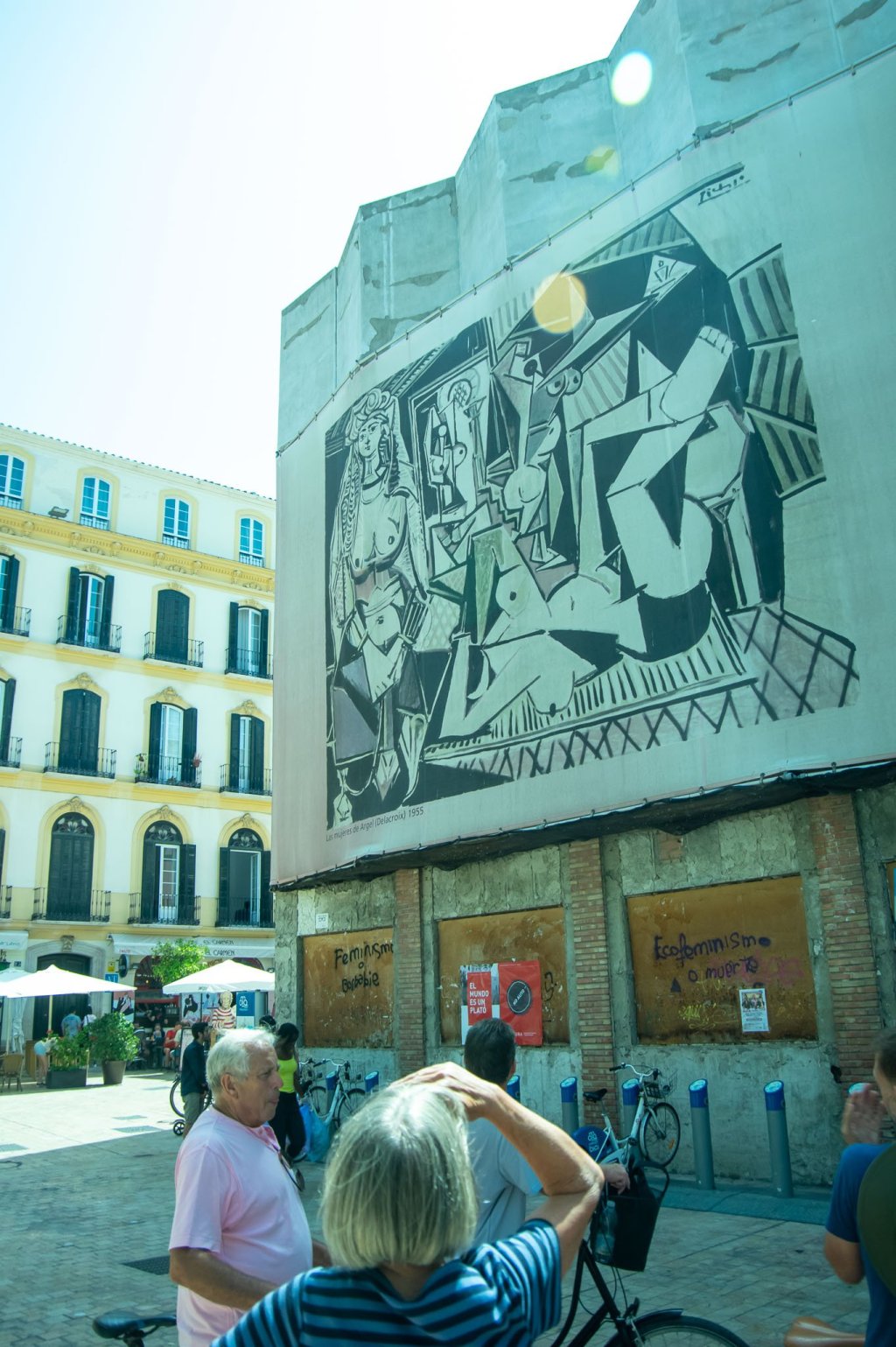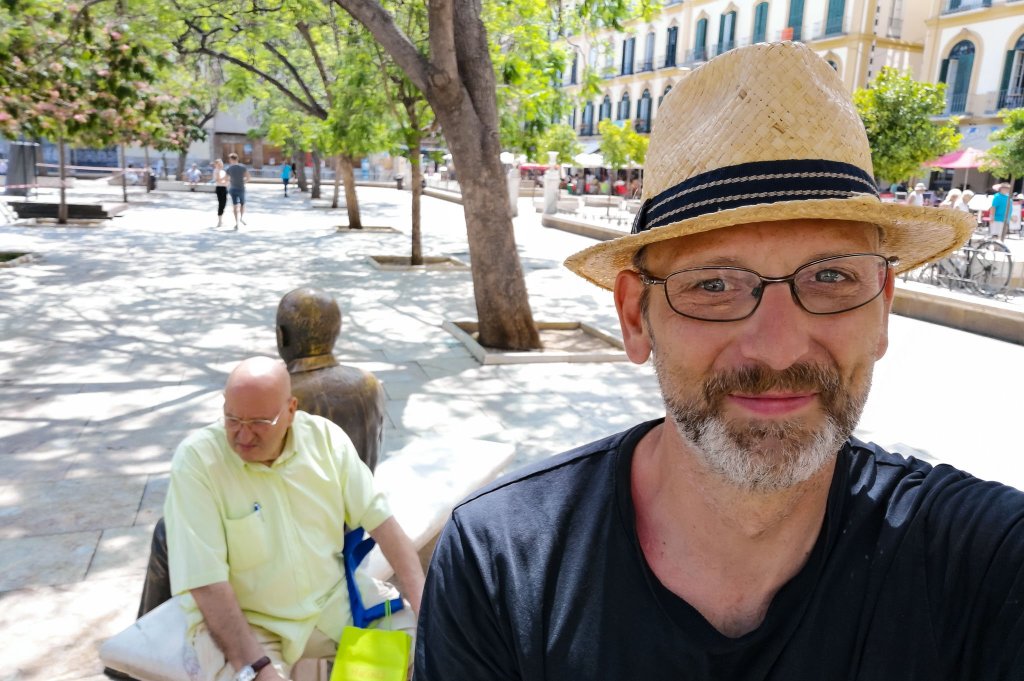Bike tour Malaga

Cycling the Andalusian capital
One of the great things about our membership in the Cycle Cities network is the fact that you get to meet like-minded people from all over the world that are the perfect first point of contact in a foreign city. In the past we were already lucky enough to go on bike tours in Budapest, London, Lisbon, Hamburg and most recently Munich . In the case of my summer trip to Malaga, Kay and her company Malaga Bike Tours, were the final reason for me to pick Malaga as my mid-season destination. After a very busy spring and some big projects threatening our winter hibernation I thought I needed a couple of days breathing a different air.
So, I booked a cheap AirBnB in the suburb of El Palo, a neighbourhood that used to be just a fishing village only 20 years ago and right now is about 30% along its trajectory of gentrification. So, it is largely respectable but even as a tourist you notice it’s a bit shady – a lot of bad tattoos and even worse dental care, cheap seafood and someone smoking a spliff at the beach literally every couple of steps – long story short, it was perfect, a bit like what Neukölln would like if it was by the sea. Located about 7km from the city centre I could’ve taken the bus for my 1st ride into the city proper (public transport seems cheap and more or less reliable and consists mostly of busses and a subway), instead I opted for one of the ubiquitous electric kickscooters (here, here or here) Malaga had been flooded with. Turns out, they’re really fun, even if it hurts a bit to admit that. Since there is no proper cycling infrastructure, bikes, pedestrians and scooters all use the sidewalk, The only cyclists actually riding on the road are fast-looking roadies in tight Lycra (doesn’t mean they’re actually quick as it turns out). Point in fact: as a regular means of transport bikes are virtually non-existent and Malaga is ruled by cars and pedestrians with bikes even prohibited from entering the old town.
Anyway, Malaga Bike Tours is located a stone’s throw from one of the most prominent plazas and the main tourist information in a neighbourhood recently rebranded as Malaga Soho in a rather desperate gamble to create some marketing buzz for it – more on that later though. The first tour I did was the
City Bike Tour Malaga
I joined a lively group with three British best-ager couples one of whom had a winter home at the Costa del Sol and to sum things up we had a lot of fun together. Our guide’s name “Jesus” helped a lot to ease people into the tour and by the end of his introduction we were already laughing together. For this tour we were riding regular city bikes, but the company has trekking and mountain bikes for hire as well, if you want to go offroading for a bit. According to the locals, Mountainbiking is spectacular in Andalusia- we might have to come back and check in the winter.
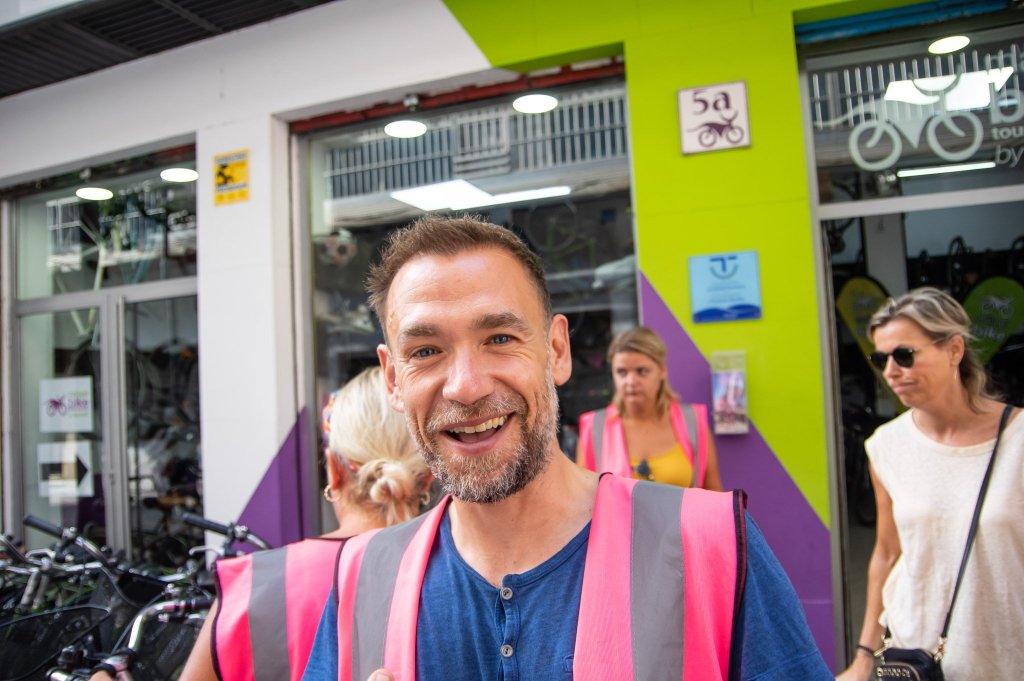
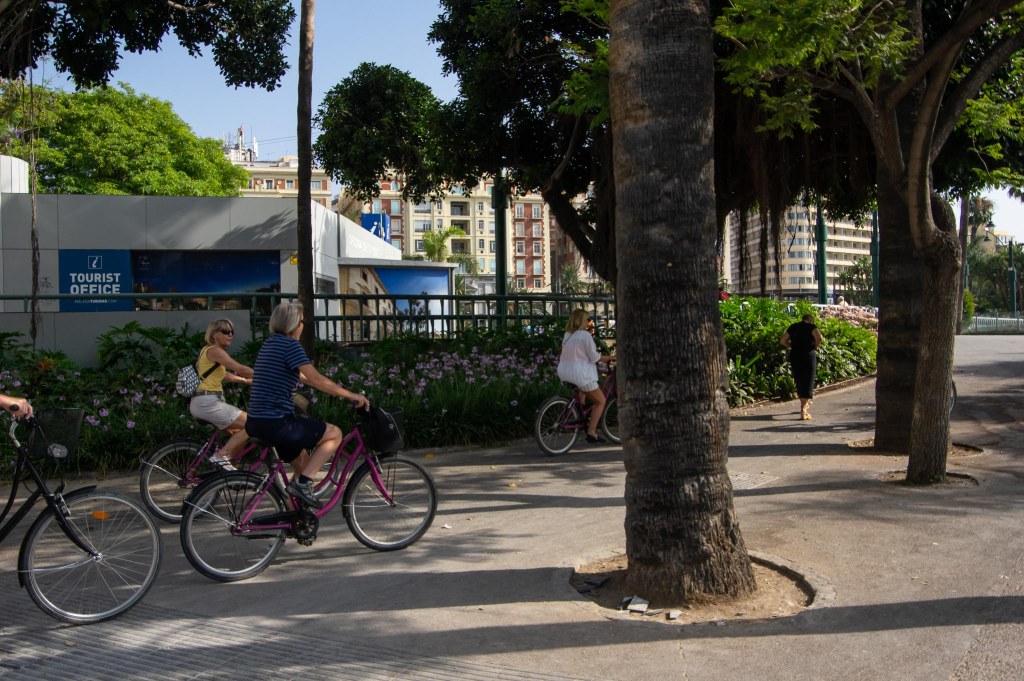
On the way to our first stop on the Malaga City Bike tour.
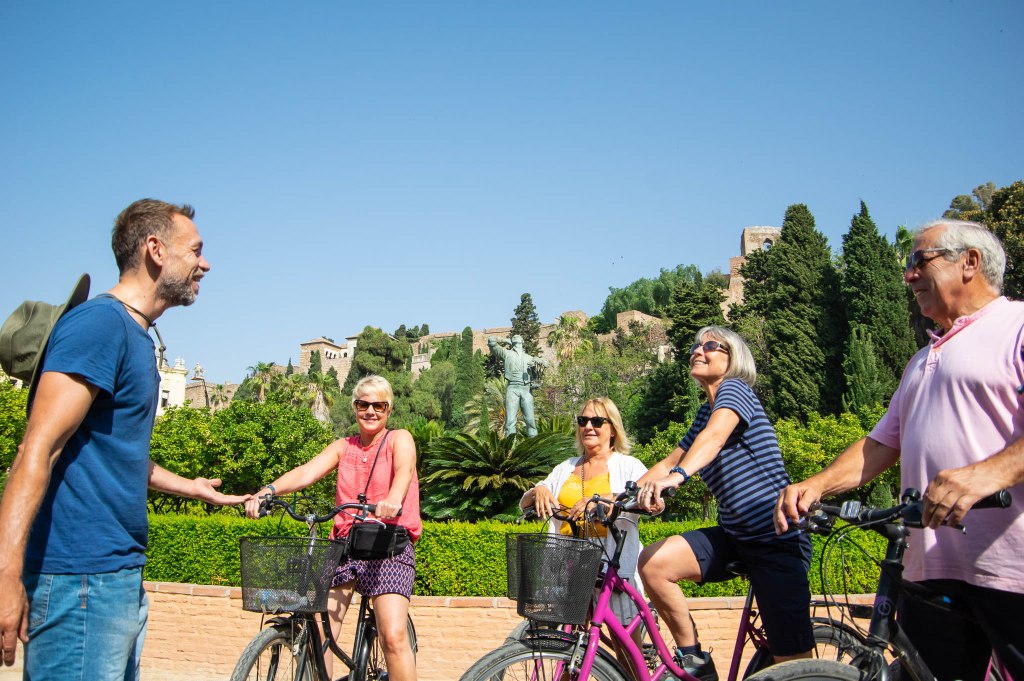
Malaga is incredibly green, there are trees and lush parks everywhere. In the background is the Alcazaba, the old moorish fort/palace.

Statue of a flower vendor in front of Alcazaba. I can remember there was a story to it, but the story itself escapes me at the moment.
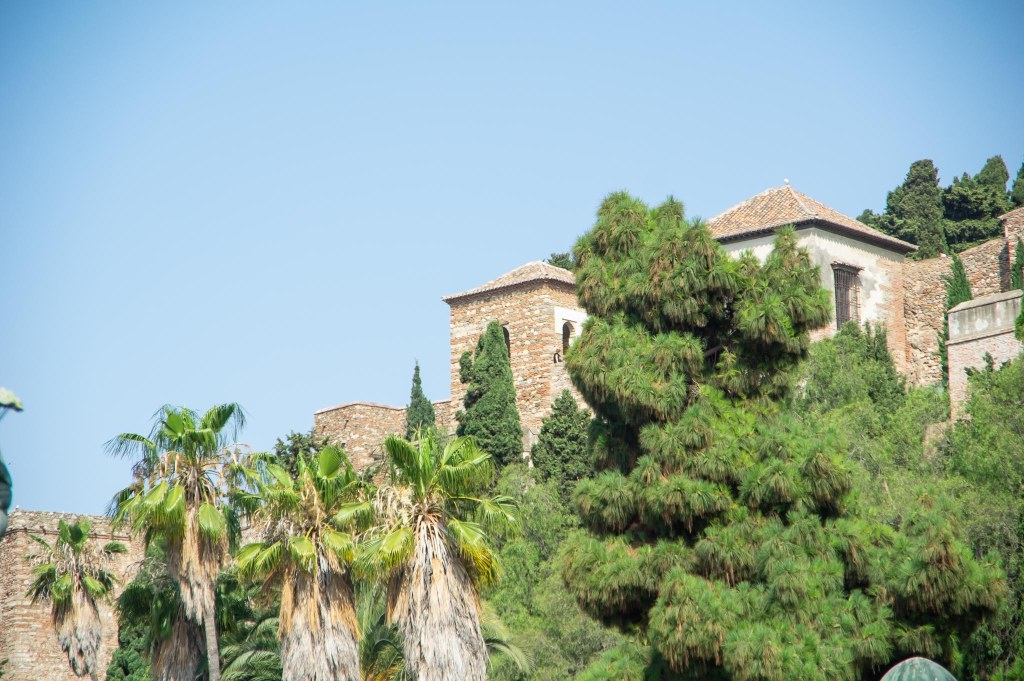
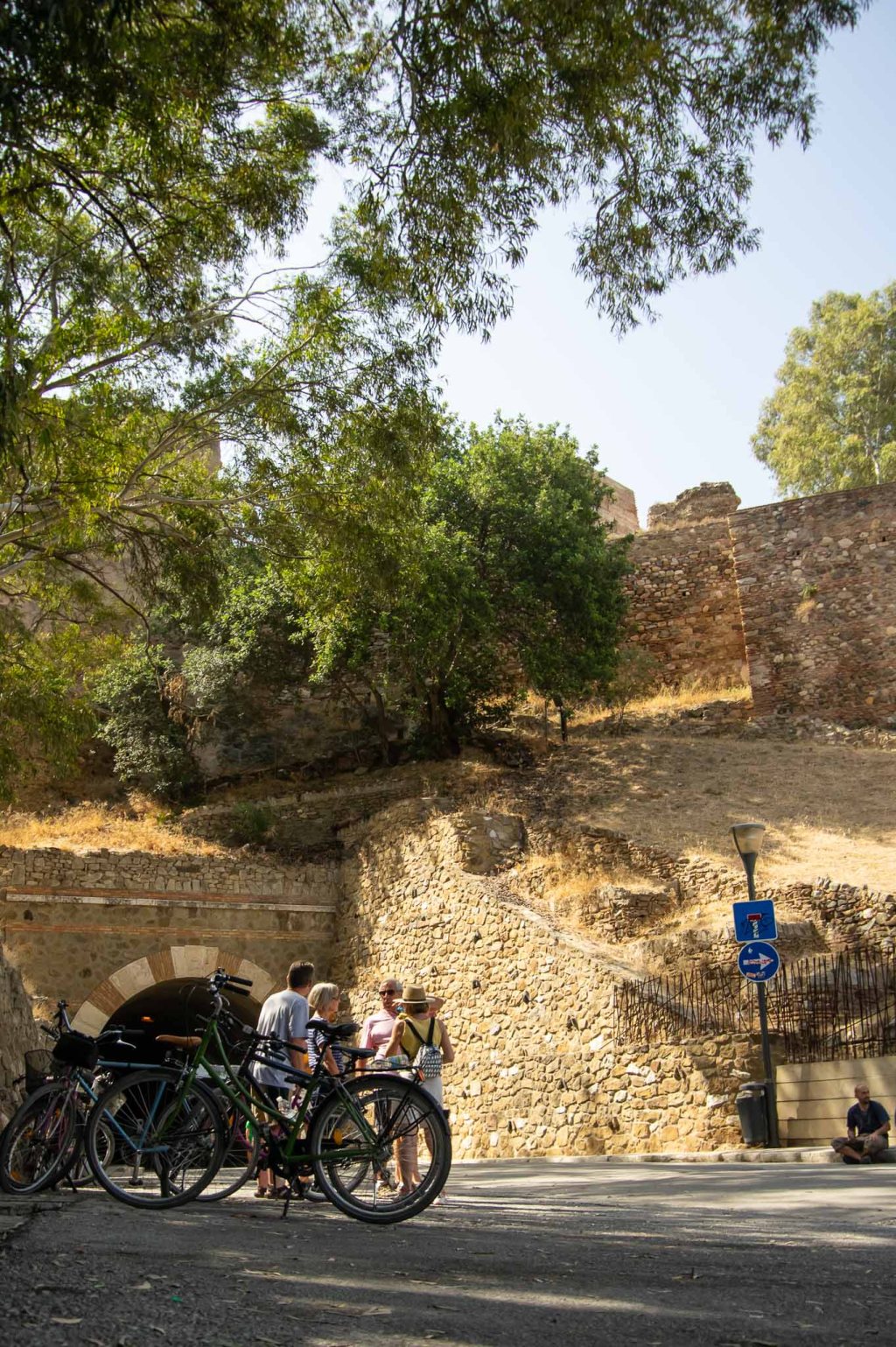
The ride up to Alcazaba was seriously steep.

Malaga: 3.000 years of history
We in Berlin were very good at putting as much history in the last 130 years or so, that we tend to forget how much older some cities are and Malaga has been an important port for nearly 3 millenia. First the Phonecians created a colony – Malaka (yes like the only word in Greek that you know, shame on you!) whose success was largely based in their ability to cure fish to make it last longer, a key technology for long sea voyages. After the fall of Carthage, the Romans took over and made it one of the hubs for the production of Garum – a fermented fish sauce, the Romans loved; then the Roman empire disintegrated and Visigots fought Constantinople for it until 616, when king Leovigild made the city his. Just a 100 years later moorish troops started their conquest of Spain and for the following 800 years Malaga, Andaluzia and large parts of the rest of the country became a part of the islamic world. This wasn’t a unified empire as the West has seen it, but like every other political entity at the time was susceptible to infighting and changing levels of influence. Without going into too much details about the different kingdoms/emirates the high middle ages in Andaluzia are one of the very examples in history where Christians, Jews and Muslims lived more or less peacefully together. Of course Non-Muslims had to pay a special head tax and were barred from important government jobs, but they were allowed to worship as they pleased and were an integral part of society. Science and art florished, many classical texts from the wise men of Greece like Aristotle and Plato were translated in the extensive libraries at Cordoba, Malaga and Grenada making the region THE powerhouse of knowledge in Europe, centuries before Christians built the first universities.
Starting in the early 15th century the Christian Spanish kingdoms started their fight to take Spain (back). This process is mostly referred to as the “Reconquista” which is misleading insofar as it never was part of a consolidated Christian kingdom before that. In the end it was the aforementioned tolerance that broke the emirate’s back. The muslim rulers of Northern Africa were very far from being tolerant and without their support Al Andalus couldn’t hold out against Aragon and Castille. Jews and Muslims were either killed, had to convert or had to flee and in the following decades those that stayed had to prove they really were Christians time and time again. Supposedly that is one reason why pork plays such a big role in the Spanish cuisine and why Spanish people even today all have half a dozen – Christian – middle names. I mean it’s completely logical; of course you are more Christian the more Christian names you have, right? This phenomenon might be responsible for the Malaguenos’ love for religious processions as well. Almost every male citizen is a member in a religious brotherhood and especially around Easter these take over the streets with costumes and giant statues of the Virgin Mary they carry around for a whole day.
Malaga’s major sights
We start with a ride through Parque de Malaga along the main thoroughfare were institutions like the city hall are located in impressive buildings. Even though water is a coveted resource the city has a lot of these super green oasis featuring giant banana and ficus trees that create the illusion of being in a little piece of jungle. I can’t really begin to imagine the infrastructure you need to keep this city green, but I’m happy for the effort, even on the hottest days, a lush, shady resting place is never far away in Malaga.
Our next stop on our Malaga Bike Tour was the Alcazaba (Kasbah) an impressive 11th century palace and fortress complex that sits atop a little hill overlooking the city and the Roman theatre at its base. Visits used to be free, now they charge a low fee to see inside Alcazaba and it’s sister fortress Gibralfaro and even though we didn’t have time for a closer look on this tour, I can recommend a visit without limitation. After a quick overview of Malaga’s skyline from a viewing balcony we breezed down the road to Plaza de la Merced, a former market place at the edge of the historical centre that is mainly famous for the fact that Pablo Picasso’s house of birth is located at its northern end. To honour him they set a statue of the great maestro sitting on a bench and it seems to be something of a lucky charm to rub his bald head, at least its very shiny unlike the rest of him. The obelisc in the square centre commemorates the execution of 48 revolutionary sailors, whose tomb is located beneath. On one side there’s a list of names including that of Robert Boyd, who didn’t really care about the end of Spanish monarchy. Instead, according to legend, young Robert was looking to become a pirate and was somehow shanghaied into this botched revolt against the Spanish crown.
Unfortunately I didn’t take any pictures of the Mercado Central, because I thought I would come back for a dedicated photo session but then never did. So let me try using words for this remarkable sensual experience. One thing you have to know about the Spaniards, they are obsessed with food. About the only time restaurants are empty is at the time we actually have dinner in Northern Europe, so between 6 and 9 pm, and most people don’t eat before 11. The market, housed in an old arab boatyard that saw many different uses since its erection in the 15th century, is a cacophony of impressions, smells, sounds and the endless colours of local vegetables and fruit. The choice of first rate meat and seafood is beyond anything we have in Berlin and that for a fraction of the price. Most stallholders are happy to let you try something if it is believable you’re actually going to buy something, and there a number of small bars that sell very tasty tapas. It’s closed in the afternoon, so make sure you come on time.
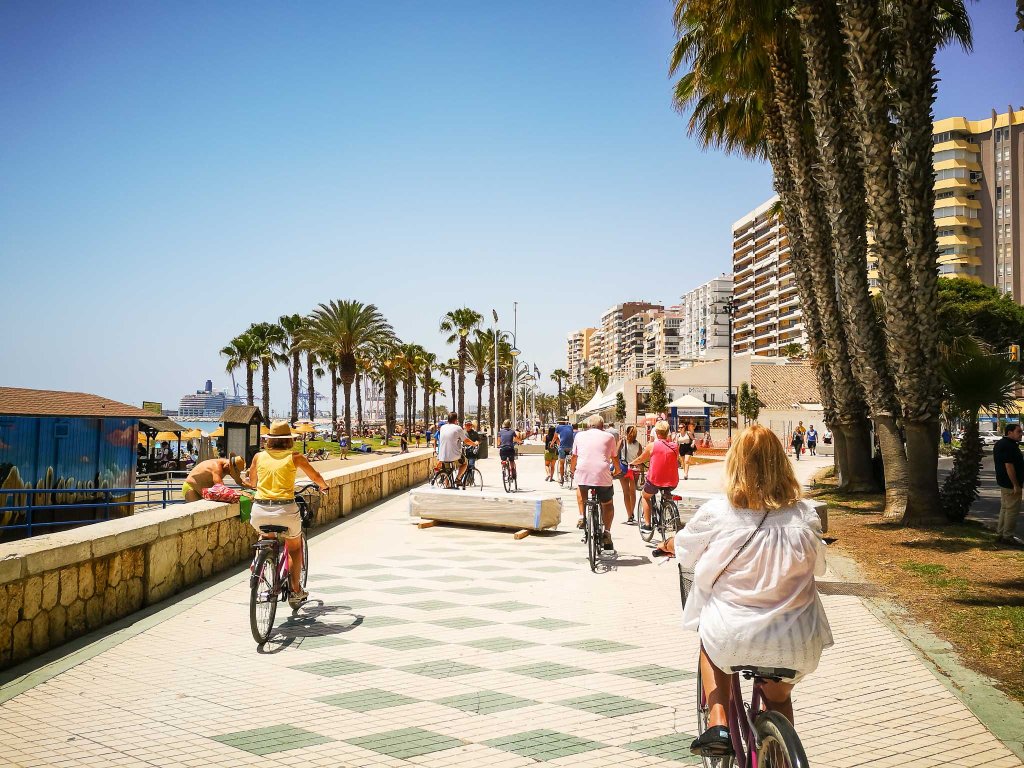
The combination of a big city with all its cultural amenities and the beach is simply amazing in Malaga.
For the next leg we got off our bikes for a short walk to the One-Armed Lady – La Manquita, officially named Santa Iglesia Catedral Basílica de la Encarnación it got its nickname from the fact that the second tower was never finished. It seems like some of the funds for the construction were simply ‘redirected’ and now they just keep it like that, after all a lot of cities have a two-towered cathedral, but only Malaga has this half-finished crooked thing, that looks a bit like a tooth is missing.
Just on the back of the cathedral is the Museo de Malaga (btw all museums I went to didn’t charge an entrance fee if you were an EU citizen) housing both a fine art and an impressive antiquities collection spanning 4 millenia of settlements in the region. Originally built as a customs station it later became a tobacco factory before the National Police used it as a jail and storage facility. There’s an apocryphal story about Frank Sinatra. During the shoot of the movie Von Ryan’s Express Sinatra allegedly picked a fight in the hotel bar he was staying that landed him in prison for a while and a life-time banishment from Franco-ruled Spain. It might not be true, after all, if Sinatra would’ve done only half the crazy shit people attribute to him, he never would have made any movies or records.
The last stage of our bike tour then took us along the city beach Playa La Malaqueta the bullfight arena/corrida, past the Centre Pompidou Malaga with its colourful installation on the roof and along the harbour. For a city that gained its position as one of the most important ports in the Western Mediterrenean it is surprisingly small and not that busy. These days Malaga’s port doesn’t even make the top 10 port-cities in Spain. They’re not even number one in the region with Algeciras just down the coast and the Spanish exclave Melilla just across the sea on the Morrocan coast. The dwindling importance of the port and the death of the small independent fishing industry led to a major decline for Malaga’s economy in the 2nd half of the 20th century. And even when tourism started to pick up from the 60s on, that didn’t really help. Most guests would just use the city as their point of entry and then proceed to their tourism beaches along the coast right away without spending a dime. Over the last 20 years Malaga has been on the rise again. A lot of investment in culture and infrastructure are as responsible for that as changed travel habits. These days no one wants to be a tourist, we all want to be travellers that dive into a place’s vibes and for a lot of people just sitting at the beach for two weeks would be just a bit boring. And considering that Malaga is a perfect city. You got the sea and the beach in front of you, mountains climbing up to 1500m almost right behind the city and a lot great of experiences in between, including some of the best and most affordable sea food I ever had. Temperatures rarely go above 30/32 °, there’s a bit of wind coming in from the sea almost constantly and even in winter it never get’s colder than 15°. With around 325 days of sunshine, good weather is almost a guarantee and live in general seems a bit more laid-back than in our busy-busy northern cities.

Malaga cathedral – the one armed lady/La Manquita – or more officially Santa Iglesia Catedral Basílica de la Encarnación
Thank you so much again, Kay, for hooking me up with a bike to explore your brillant hometown. We’re pretty sure we will be back to explore some more – and then we need someone to show us the best trails.
Basic Info Malaga Bike Tours.
Malaga Bike Tours & Rentals
C/ Trinidad Grund 5a
29001 Málaga (Google maps)
T (+34) 951 138 349
T (+34) 606 978 513
E info@malagabiketours.eu
Standard tours are 3 hours, appr 12-15 km and set you back 25 € as an adult and 19,50 as a student/minor. Bike rental is 12 €/day for a city bike and 24€ for an MTB, with steep discounts from the 2nd day, e. g. a city bike for the week is just 50€ – that’s -40%! Make sure to say Hi from us when you visit them, we promise you won’t be disappointed.

